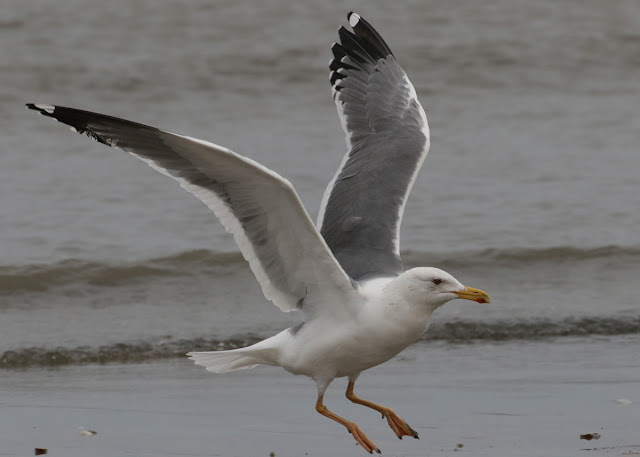Cue collective groan... is mid-summer really the time to be talking about gulls? Don't we get enough of it in winter? As it is the gulling season is getting more and more like the football season; longer!
For most birders, me included, it's a time of respite from gullers trying to convince us that an elastic feature of taxon A is important when compared with the equally inconsistent feature of taxon B. As an example, look no further than Olsens Gulls where the caption to figure 594 reads "Note larger white mirrors on P9-10 than in
heuglini." while on the facing page figure 588 the only gull clearly showing p9-10 in a flock of Heuglin's Gulls taking flight has larger mirrors. No wonder putative vagrant gulls are a nightmare.
Olsen treats
taimyrensis as a hybrid between Heuglin's and Vega, yet Klass van Dijk
et al (Taimyr Gulls: evidence for Pacific winter range, with notes on Morphology and breeding, Dutch Birding 2011) refer to various Leibers papers claiming "Genetic analysis has shown they represent a distinct population, ie, with a measurable degree of genetic differentiation and without obvious introgression...". If correct, this would knock the widely held hybrid swarm theory very firmly on the head.
I haven't had time to get into the field since my Least Tern trip so I've been looking through the huge number of Taimyr Gull images taken during my March and April gulling sessions in Mie. Hence the untimely subject. If truth be told I think my time would be much better spent trying to work out which of the phalanx of trash receptacles along my kitchen wall is best suited to take this plastic-lined metal bottle cap. At least there's a possibility of coming to a satisfying conclusion - even if it isn't the right one. With gulls I wonder whether 'satisfying' or 'right' are ever likely to apply.
So coming to the birds I saw in spring. Taimyr Gulls are far out numbered by Vega in early March when I saw these first examples...
 |
| Taimyr Gull on the right hand end of a flock of Vega (8 March 2016). Note the long shadows; the weaker late afternoon light makes picking out the darker saddle that much easier. |
 |
| Closer views of the same bird moving through the Vega flock. |
 |
| It looks very typical for this time of year. |
And another individual the next day...
 |
| Though it appears paler-saddled in this image it didn't amongst the Vegas on the beach, but here it's standing on a roof top so perhaps the angle and lighting make a difference. The irids of this individual are heavily speckled and likely to give a dark-eyed impression at longer distance. |
 |
| The same bird as above. Though generally outer primaries vary in the extent of black shown, both towards the bases and sub-terminally, as well as in the size of mirrors and apical spots, there's far less variation compared to Vega and this bird is a fairly average example though many would show black to the base of the inner web of p9. |
A month later things were getting more interesting with fewer Vegas and more Taimyr present. I photographed a large number of Taimyr on both the 8th and 9th of April but it's impossible to do them justice in a single post. So I'll post more typical individuals here and some interesting shots of very late moult and also displaying birds in another post.
 |
| A fairly standard bird on the left (with Vega) but perhaps with the most saturated hind-neck markings I came across this spring. |
 |
| A large p10 mirror almost reaching the tip. I only found a single individual where the mirror broke through to the tip. |
 |
| A very similar looking bird, again with a very large mirror. |
 |
| Irids range from heavily speckled to clear. |
 |
| I'd class this as a young adult showing limited black on both mandibles. |
 |
| It also has dark markings on the outer greater and lesser primary coverts. |
 |
| This is the same gull the following day, different light conditions giving a much darker-saddled appearance. |
Jumping forward in time; my last very brief gulling trip was on 20 April when gull numbers were much reduced. I counted about 40 Vega and 6-7 Taimyr, only Black-headed were lingering in numbers, with around 400 still present.
 |
| April 20, not many gulls left. A Taimyr (left) with Vega and four Black-headed. |
 |
| The same gull as above. |















No comments:
Post a Comment